Establishing a world standard for environmental sustainability and economic stability, serving as a model that balances human activities such as resource extraction and tourism with conserving its environmental values and wilderness state over time.

WELCOME to the MUSKWA-KECHIKA Management Area!
The Muskwa-Kechika Management Area (M-KMA), situated in northern British Columbia, Canada and was designated in legislation (M-KMA Act and Regulation) in 1998. It is a globally significant area of wilderness, wildlife, ecosystems and cultures, that must be maintained in perpetuity. World class integrated resource management decision-making must be practiced ensuring that resource development and other human activities take place in harmony with wilderness quality, wildlife and the dynamic ecosystems upon which they depend.
Management direction for industrial activities within the M-KMA differs from management direction for industrial activities outside of the "M-KMA. Within the M-KMA, the emphasis of management direction is to maintain in perpetuity the wilderness quality, the diversity and abundance of wildlife and ecosystems upon which it depends while allowing resource development. Outsie of the M-KMA, the reverse is often the case i.e. management direction is to maintain resource development opportunities to sustain the economic base of communities while maintaining high outdoor recreation, wilderness, wildlife, and biodiversity values for future generations.
Recent News
Honouring Phil Zacharatos FEB 14, 2024
Premier report - 2021 jan 28, 2022.
New interactive report to the Premier from the M-KAB.
CBC TV profiles M-KMA - 2021 SEP 10, 2021
Watch “In the Land of Dreamers” on CBC Gems.
The Muskwa-Kechika Management Area (M-KMA) is one of the Earth’s treasures in terms of its raw beauty, isolation, biodiversity, wildlife, wilderness, natural resources and spiritual and cultural values. Management of the M-KMA is founded on maintaining in perpetuity four resource values identified in the M-KMA Act and Regulation and the Board’s vision. The four resource values are wilderness quality and characteristics, wildlife, ecosystems all of which are critical to the social and cultural well-being of indigenous and other peoples in the area. Resource development may only proceed where there is no permanent or significant negative impact to the wilderness, wildlife, ecosystems and cultural values of the M-KMA.

Wildlife Values
Read More
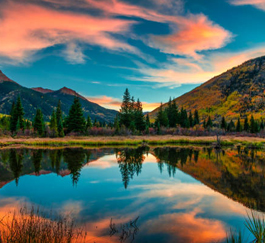
Wilderness Values

Ecosystem Values

Cultural Values
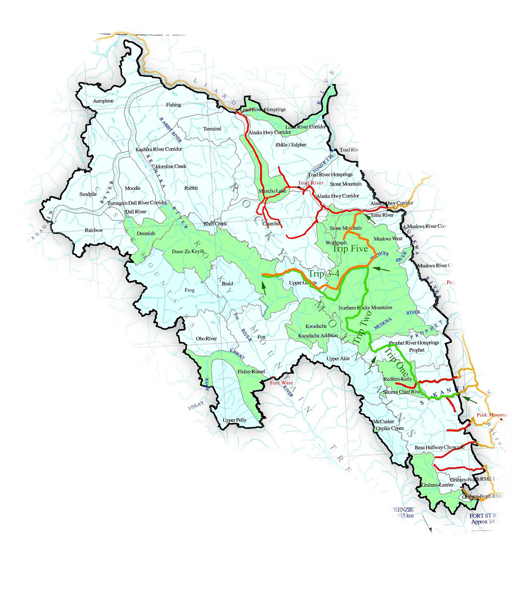
Muskwa-Kechika Quick Facts
Translated, Muskwa means Bear and Kechika (Ketchika - Táhdáséh) means long inclining river
FIRST NATIONS
The M-KMA lies in the traditional territories of the Kaska Dena, Treaty 8 and Carrier-Sekani. The following are First Nations Communities found within or adjacent to the M-KMA.
Kaska Dena First Nations : Daylu Dena Council, Dease River First Nation, Kwadacha First Nation, Liard River First Nation.
Carrier-Sekani: Tsay Keh (say-kay) Dene .
Treaty 8 First Nations : Blueberry First Nation, Fort Nelson First Nation, Halfway River First Nation, Prophet River First Nation
SEARCH THIS SITE
Muskwa Kechika
- Alaska Highway
- Liard River Hot Springs
- Ancient Forest
- Guided Adventures
- Photography
- Tumbler Ridge UNESCO Global Geopark
- Winter Experiences
- Historical & Cultural Experiences
- The Big Five
- 10 Day Trip
- 14 Day Trip
- Visit Responsibly
- Know Before You Go
Home / Experiences / Muskwa Kechika
ONE OF THE LAST TRACTS OF WILDERNESS SOUTH OF THE 60 TH PARALLEL
The Muskwa-Kechika is an immense expanse of wilderness that spans over 6.4 million hectares (15 million acres). This stands as the largest protected area in Canada’s Rocky Mountains and the most biodiverse, with one of the highest concentrations of differing plant and animal species in North America. For thousands of years, the First Nations of Northeast BC have lived upon this land and utilized its resources for hunting and gathering. Today, as result of a historic agreement, this area is protected, preserved, and managed as a working wilderness.
Visitors here can explore on multi-day horseback trips with Wayne Sawchuck, who has been guiding expeditions in the area for over 35 years. For those who wish to discover the area by motorized vehicle—ATV, snowmobile, or boat—can do so through the Access Management Area (AMA) routes. For hikers, Northern Rockies Fitness offers hiking retreats and experiences for those looking to make a trek. It is strongly recommended to experience this wilderness area with a guide, tour operator, or expedition company.

Travel advisories happen. Check DriveBC.com before heading north .
The density and diversity of wildlife—moose, black and grizzly bears, bighorn sheep, elk, caribou, wolf, stone’s sheep, wolverine, and more—is just one of the reasons why the muskwa-kechika is a truly remarkable place..

More from the blog
A guide to winter in bc’s northeast.
Skip mountain villages with bustling crowds and instead make your way to BC’s Northeast — a region that knows how to do winter well.
Wilderness Lodges and Campgrounds in Northeast BC
The raw and rugged scenery of BC’s Northeast is anything but ordinary. From lakeside A-frame cabins to remote fishing outposts set deep in the heart of the Muskwa-Kechika, here are nine cool stays that aren’t your average hotel.
Paddling in BC’s Northeast Region
One glimpse at Northeast BC’s lake-dotted landscape reveals a paddler’s paradise, one that promises few crowds and plenty of scenery. Here you’ll find pristine waterways framed by sweet-smelling pine and spruce forests and well-stocked lakes, home to rainbow trout, walleye, and northern pike.
YOUR TRAVEL GUIDE
Sign up to our newsletter for the latest experiences and guides

Explore the Northern Rockies
About MK Adventures
The Muskwa-Kechika Management Area (M-KMA) is located in northeastern BC and encompasses 6.4 million hectares (16 million acres) of land with varying levels of conservation, preservation and land use practices. Named after two great rivers that flow through it: the Muskwa and the Kechika, it has more species in greater abundance than anywhere else on the continent and that makes it of global importance.
The M-KMA plan was conceived in 1993 by Wayne Sawchuk and George Smith. While looking at British Columbia Ministry of Forest’s Inventory of Undeveloped Watershed maps in 1992, Wayne noticed a network of fifty pristine watersheds. Miles away, George was looking at the same maps. It was not long before a productive partnership was formed.
The pair was ideally matched. Wayne had intimate knowledge of the area. He was familiar with many of the region’s stakeholders because he had engaged in local logging, hunting, guiding and trapping activities for most of his life. He understood the land and the people. At that time, George was the national campaign director for Canadian Parks and Wilderness Society (CPAWS). He was used to dealing with the political arena and knew how to garner funds. Wayne rolled up his sleeves to build community, while George found funding to map the ecological and resource values of the land.
It was perfect timing. The British Columbia government was initiating Land Resource Management Plans (LRMPs) for various areas of the province. The goal of the LRMPs was to have multi-stakeholder planning tables mutually determine how to best utilize each LRMP area. Wayne and George worked at the Fort St. John, Fort Nelson, and Mackenzie LRMPs to ensure that the the M-KMA model was considered in each table’s final plan, and fortunately the planning tables ultimately did so.
In 1998 the M-KMA Act was officially established by legislation.
A Model of Success
A volunteer consensus-based advisory Board whose members represent diverse perspectives advises government on the management of the M-KMA. The Premier of the province chooses this Board. The Board works to maintain the M-KMA values, strives to keep government, industry, First Nations and other stakeholder groups well informed, and makes sustainable economic recommendations to the government.
The key to the success of the Muskwa-Kechika Advisory Board lies in collaboration with all stakeholders and First Nations as well, enabling the M-KMA vision to work for everyone. The mission of the M-KAB is to “provide respected and trusted advice that ensures the dynamic ecosystems, wilderness, wildlife and cultural diversity of the M-KMA are maintained in perpetuity.”
A number of committees operate under the direction of this Board. These committees oversee projects, such as the Joint Solutions Workshop for Mining, Well Site Evaluation and Traditional Knowledge in Land Use Planning activities. Committees and projects vary according to mutually identified needs and goals. Although the M-KMA model is a world-class leader in large-scale conservation biology, its stakeholders remain ever vigilant, as changing government policies and industrial practices perpetually challenge the future survival of the M-KMA.
The M-KMA is a model for other places on earth, proving that economic development and large, intact and predominately unroaded wilderness can co-exist through responsible resource planning and land use management practices. This world-class innovative conservation model is studied around the globe, and is hailed as a leading example of its kind.
Through the tenacious optimism and ongoing efforts of people like Wayne Sawchuk, wilderness havens like this may continue to exist for centuries to come.

Muskwa Kechika Adventures
Mayfield horse camp, aug. 13-20, 2023.
Mayfield Lake (in the Dune Ze Keyih Provincial Park) offers the perfect escape and the ideal place to experience the Muskwa-Kechika. Located in the heart of BC’s Northern Rockies and nestled in the Gataga River Valley, Mayfield Lake is rich in wildlife and wild scenery. Moose and caribou can be viewed from the breakfast table and trips into the alpine provide panoramic vistas untouched by humans. With the comforts of camp life, Mayfield is a hidden gem far from the demands of modern life. The Mayfield Horse Camps are planned to include day rides to the alpine and the Gataga River Valley. Should weather allow, there may also be an opportunity for an overnight pack trip. Featuring a sauna, floating dock, outdoor timber-framed roofed kitchen, tipi, wall tents and tiny treehouse cabin, the camp also includes canoeing, nature walks, hiking, and relaxation next to the pristine lake. In an eight-day trip, two of which are flight days (scenic flights in a float plane over the majesty of the MK), a guest can expect to spend roughly half of their trip riding with the rest spent engaging in the many activities that the Mayfield camp offers.
Day One: Floatplane flight to Mayfield, guest orientation, settling in
Day Two: Horses are brought in, introductory ride to the Gataga River
Day Three: Pack trip to Shoulder Mountain (this is approximately a 6-hour ride and includes walking up (and down on return ride) steep sections
Day Four: Camp Day at Shoulder Mountain exploring the surrounding alpine and ridgetops
Day Five: Pack trip to Paradise OR Sodel Valleys from Shoulder Mountain
Day Six: Pack trip back to Mayfield Basecamp
Day Seven: Camp Day at Mayfield – canoeing, hiking, exploring the boreal forest surroundings
Day Eight: Float plane flight back to Muncho Lake
TO JOIN IN ON THIS ADVENTURE OF A LIFETIME EMAIL [email protected] FOR INQUIRIES AND REGISTRATION.
PRICE: $4750.00 Payment plans can be arranged. $500 non-refundable deposit. Minimum of 6 people.
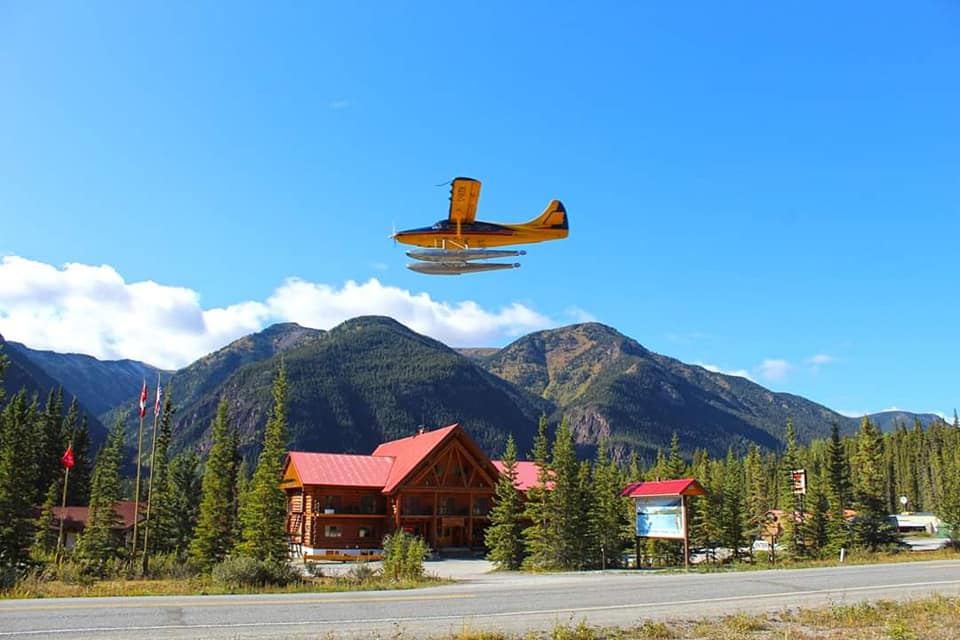
Floatplane flight to Mayfield, guest orientation, settling in.
You’ll be treated to a dinner and breakfast for your arrival of the Aug. 12, 2023. Enjoy a flight into Mayfield Lake from Muncho Lake in the morning. A trip over the Northern Rockies to the Gataga River Valley is an adventure in itself. You’ll get to see mountain ranges that go on for what seems like forever.
Horses are brought in, introductory ride to the Gataga River.
You’ll get to watch horses almost daily get packed, and unpacked for the trail ahead. We’ll be doing a day trail ride around the Gataga River to start off the trip returning to the Mayfield Lake that evening for a meal cooked on the fire.

Pack trip to Shoulder Mountain (this is approximately a 6-hour ride and includes walking up (and down on return ride) steep sections.
These ponies are raised in these mountains, there is no better way to trust the ground than watching a horse take the steps for you. Horseback riding is a very rewarding and accessible activity for all of us, which gives us the possibility to disconnect from the world, ride on trails and discover landscapes during our riding holidays.

Pack trip to Paradise OR Sodel Valleys from Shoulder Mountain. When we say you get time in the saddle we mean it by we get to see views only a few in the world will see and we get to cover ground faster than most. Saddle up and relive the outfitter way of life on a spectacular horseback tour. Travel through the high country, across vibrant alpine pastures and over mountain passes to see the Muskwa Kechika from a different perspective.

Our goal for our Mayfield Camps is to make a visit to the amazing wilderness of the Muskwa-Kechika as easy as possible, and at the same time a whole lot of fun. Perhaps you wish to spend solo time far from our industrial world, or simply to photograph or sketch the landscapes and animals of the wilderness. Maybe you prefer to experience the wilderness from the back of a horse, or to explore an animal trail on foot, deep in the boreal forest. How about listening to the call of a loon or the plop of a jumping fish as the pre-dawn shadows begin to lift? All of these experiences are possible at Mayfield Lake, not to mention the wonderful meals and spontaneous campfire chats that challenge and invigorate.
1-Night Stay at Muncho Lake Lodge with dinner & breakfast included Aug. 12, 2023.
Float plane IN from Muncho Lake to Mayfield Lake, BC.
Float plane OUT of Mayfield Lake to Muncho Lake, BC.
Guided day hiking trips with two experienced guides.
Camp & horse staff.
Cook and food (excluding drinks – alcohol and snacks) will be all inclusive. Please advise trip organizer of your dietary restrictions.
Canoe and sauna use.
Horse trail ride to locations.
1 group zoom meeting to discuss gear packing and any questions you may have. Zoom meeting details will be emailed out closer to the date.
NOT INCLUDED:
Hikers will need to bring their own tents, day hiking bag, sleeping bags, foamies, and personal gear. All gear will be carried by the horses except dy bag.
Transportation to Muncho Lake, BC.

MUSKWA KECHIKA ADVENTURES

Travel costs to reach Muncho Lake or the trailhead are the responsibility of the participant. Here are a few options:
1. Air service to Fort Nelson is provided by Central Mountain Air. The most economical airfare includes flights from Vancouver to Prince George with a major carrier like Air Canada or Westjet, and then a flight from Prince George to Fort Nelson with Central Mountain Air.
2. Folks can also fly to Fort St. John and obtain ground transportation with Peak Wyld Co from there. Please contact us if you would like to discuss this option.
Guided Adventure Tours 📍 - Northern, BC & Wyder’s Adventurous Momma 👶


Interactive Travel Guide
Muskwa river adventures.
, Fort Nelson 250-775-0760
Offers wildlife viewing, guided hunting trips, fishing, rustic camping adventures, sightseeing, and photo safaris. Doug and Sandy McKee have a passion for the outdoors, hunting, boating and the experiences our natural surroundings provide and they truly enjoy sharing it all.
The services offered at this business may have been affected due to COVID-19, please contact them for the most up-to-date information.
Advanced Search
An Indigenous storyteller and an ex-logger's quest to protect an ancient landscape
A new film puts the spotlight on the muskwa-kechika, one of the largest wild landscapes left on earth..

Social Sharing
It's one of the largest wild landscapes in the world, and two friends — a Dene-Kwagul storyteller and a logger-turned-conservationist — want to ensure it remains that way.
The Muskwa-Kechika is a 16 million-acre wilderness in northeast British Columbia. It was stewarded by Indigenous peoples for thousands of years, and today it is one of the largest remaining tracts of wild land in North America.
"It's six and a half per cent of the province ... and it's still in its pristine state. And by far the largest chunk of wilderness in the Rocky Mountains at this point," said Wayne Sawchuk, a former logger-turned-conservationist and wilderness guide.
But that area is increasingly of interest to resource developers looking for metals like lead and zinc, as well as oil and gas.
"People are thinking about those resources," said Sawchuk. "There's always a glint in the eye."
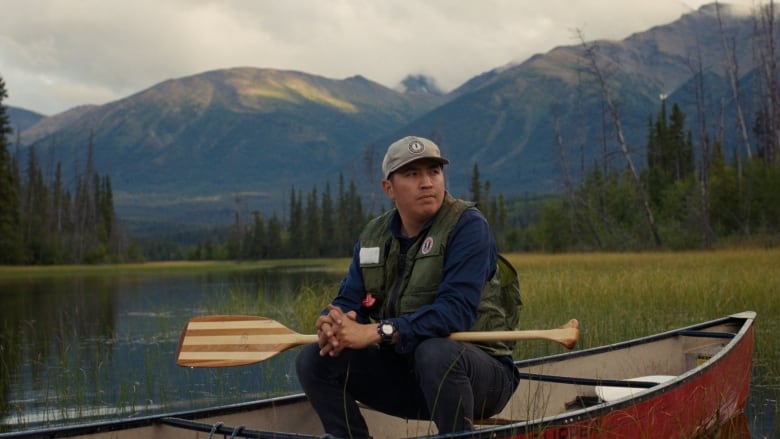
Sawchuk and Ryan Dickie, a Dene-Kwagul photographer and filmmaker from Fort Nelson, explore the region by horseback together in the new documentary, In the Land of Dreamers.
Dreamers, Dickie says, were found all over Dene territory — in northeastern B.C., northwestern Alberta and the Yukon and Northwest Territories.
"In today's context, you can relate it to prophet. People that were able to make prophecies," Dickie said.
"They were enlightened folks that I believe were still connected to the land around them, they were able to find connection with the Creator that would relay prophecies through them and they were to relay that to the people."

The dreamers prophesied that the Dene people would need a place to go back to as life would get really difficult for them, Dickie said.
They placed markers along the eastern slopes of the Muskwa-Kechika as a way of delineating the space.
"These [are] really remote areas in the Muskwa-Kechika ... you always kind of look for signs that the Dene people, my people, were there. And you still see it even to this day," said Dickie.
Sawchuck and Dickie hope the film — in which they look for these markers — shows people the magnificence of this ancient wild area, and that more people will want to lend their voice in championing it.
Dickie says this protection isn't just for our lifetimes, but a much longer period of time.
"As Dene people, when we look at places within our territories that are sacred, we don't have a mindset of within my lifetime. ... It's multigenerational," he said.
"[It's] so my son can experience the same place that I get to, and get to utilize the land the same way I get to and so on."
With files from Daybreak North, North by Northwest
Related Stories
- Top stories from British Columbia
- Daughter of 70-year-old who died awaiting emergency care says broken system killed her 'warrior' mom
- Developer, province agree to speed up construction on Little Mountain housing after 'abhorrent' deal exposed
- Campfire bans now lifted for most of B.C., with southern Vancouver Island the lone exception
- South Africa
- Philippines
- New South Wales
- Northern Territory
- South Australia
- Western Australia
- Switzerland
- United Kingdom
- Netherlands
- New Zealand
- Solomon Islands
- Itineraries
- About Travel2Next
- Hotel Reviews
- Travel2Next TV
- Travel Shop
- Explore Canada
- British Columbia
- Muskwa Kechika Horseback Adventure
Serengeti of the Rockies: Lose your heart to Canada’s vast Muskwa-Kechika wilderness 6 Oct 2016
- This post may contain affiliate links. Read our disclosure.
It’s only too easy to lose your heart to the Canadian Rockies on this amazing horseback adventure in Muskwa Kechika in British Columbia. “If you take a look up there, you’ll see a grizzly – she has triplets.” Wayne Sawchuk, environmentalist and outfitter-guide at Muskwa-Kechika Adventures sends the message down through the string of riders and pack horses.
By the time it reaches me at the end of the line, I’ve already noticed a male on the north side of the sweep of valley we’re riding through.
With a swivel of my head and glance aloft, I spy them: a female with three burly cubs – this year’s for sure due to their roly-poly size. As I watch, she sits on her haunches and they start nursing.
That means she’s totally cool with us riding by.
How to get to Muskwa Kechika
Muskwa kechika horses, gatho river camp, love crash creek.
For more about Canada read:
- 22 Incredible Landmarks in Canada
- 50 Things To Do In Canada
- Canada in Winter
- Canada in Spring
- Canada in Summer
- Canada in Fall
- 21 Traditional Canadian Foods
- Best Party City in Canada
- 10 Best Cities in Canada For Kids
- 30 Facts About Canada
- Exploring Sunshine Coast BC
- Air Canada Australia – Brisbane to Vancouver
- Train Across Canada
- The Rocky Mountaineer
- Canadian Road Trip
- Exploring The Icefields Parkway
- Driving The Alaska Highway
- The Icefields Parkway
- 13 Gardens in Canada
- Wildlife in Canada
- Best Ski Resorts In Canada
- 20 Canadian National Parks
- Castles In Canada
Muskwa-Kechika Horseriding Adventure
Life’s like that here in northern British Columbia’s Muskwa-Kechika (M-K), the largest authentic wilderness region in North America’s Rocky Mountains.
Here, as grizzlies gaze while we passed through their territory, we didn’t see anyone as we rode for 13 days through alpine meadows, wind-tossed ridges, moss-clad (surely enchanted) forests, and turbulent rivers.
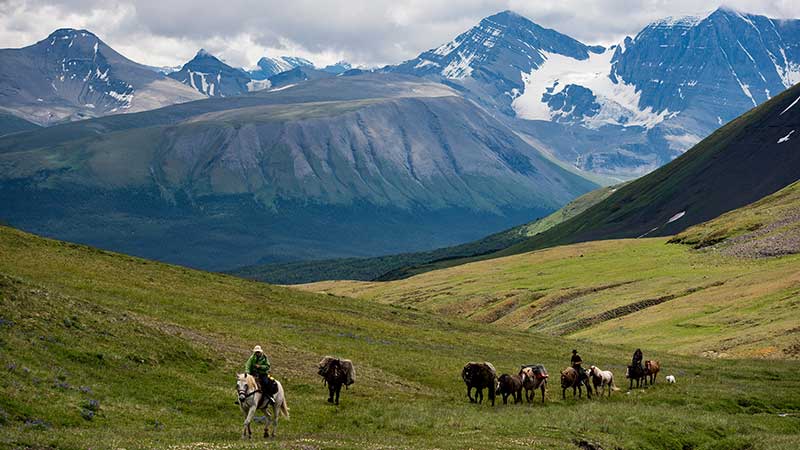
The M-K is so remote that it took us 1.5 hours to fly in from Fort Nelson on the Alaska Highway to meet Sawchuk, his two wranglers Michelle Creegan-Dougherty and Alex Lepp, plus our mounts after two days of delays.
Simply put, Mother Nature rules, where mountain summer weather sends blasts of hail, snow, pelting rain or glorious blue-sky days at whim.
As the saying goes, “Wait five minutes and the weather’ll change.”
Third-day we were lucky.
Pilot Peter Villers said to my husband Eric on our successful inbound flight, “Sure hope Wayne’s cut down those trees on the runway.”
And as we dropped onto that narrow strip – a mere slash in the wilderness – Eric thought, “Geesh, I suppose those trees are below wing-height.”
They were.
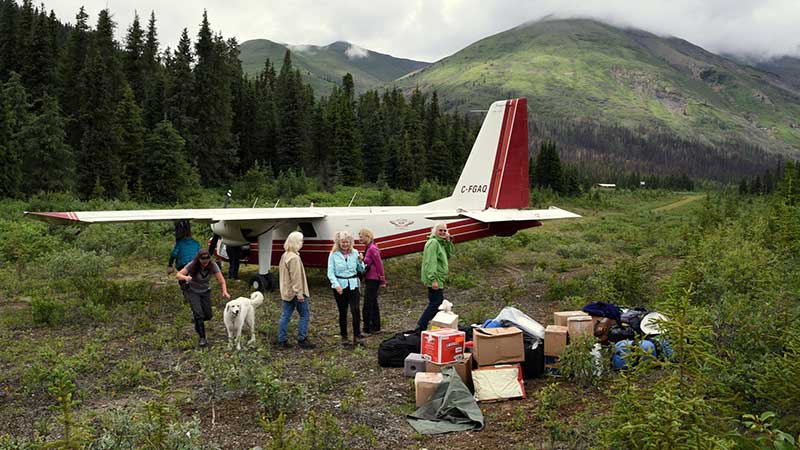
Waving goodbye to Villers and out-going clients, we turned, grabbed the 30kg (70lbs) each of gear we were permitted, and helped lug the next two weeks’ supplies to the campsite.
“Form a chain,” yelled Lepp, and we did, everyone pitching in.
That’s the way of it during these rides.
Everyone does everything, from saddling and bridling your horse to helping pack and unpack the packhorses’ paniers, cook meals over the campfire, set up and break camp.
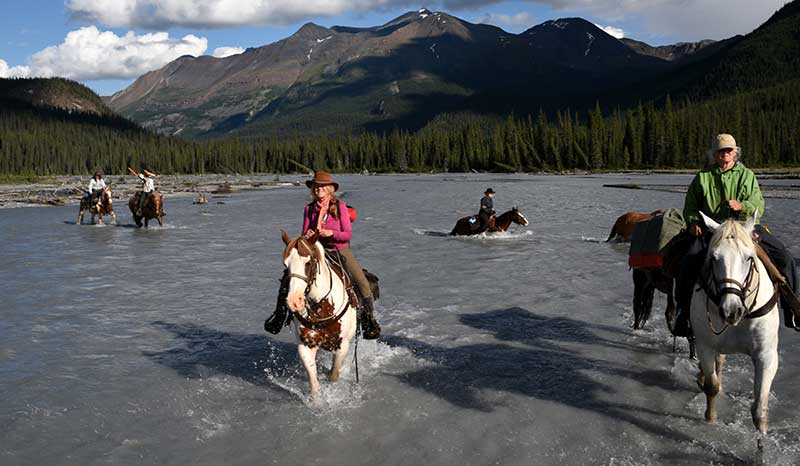
Talking about the horses, Sawchuk has a variety and several are “ambidextrous”, where they can either pack or be ridden.
Everyone loves Percy, who’s a tall, rangy, totally unflappable grey.
Then there’s Cassiar, Tuchodi and Gataga, foals Sawchuk’s raised into sturdy trustworthy souls and named for the M-K’s mountains and rivers.
Everyone forms a bond with their steed: I loved my T’suu, for instance, who was a tidy, game little soul.
Time has a way of standing still here in the M-K.
Days flowed one into another, where “weather” in the form of rain came and went but happily, never when we were on the exposed ridges and alpine meadows.
And because Sawchuk’s the only outfitter using this trail, happily there’s little environmental impact.
Sure, we’d hear him call “Alex! Bring the axe!” whereupon this agile 24-year-old would dismount Soda, his red roan mare, fight his way through the bush to the front of our line, and chop windfall trees blocking our progress.
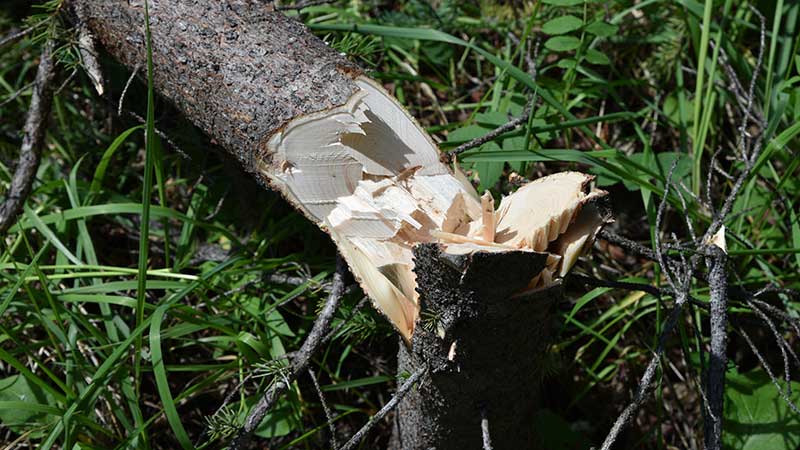
For more things to do in British Columbia see:
- 35 Things To Do In British Columbia
- 5 Artisan Chocolate Makers in British Columbia
- 10 First Nations Tours In British Columbia
- TripAdeal Canada, Alaska, USA
- Best Ski Resorts in British Columbia
- 20 Things To Do In Whistler
- Big White Ski Resort
- Four Seasons Resort Whistler
- Mount Washington Alpine Resort – Insider Interview
- Silver Star Mountain Resort – Insider Interview
Muskwa Kechika camping
Always, the horses come first.
At every campsite, Sawchuk would call, “Everyone pitch in to help with the horses: they’ve worked hard for us today.”
And we did, finding it a pleasure to help free these willing, sure-footed beasts of their burdensome packs.
Then we’d turn to our saddle horses, remove their tack (bridles and saddles) and turn them loose with the herd after putting bells on some, hobbles on others. (Hobbles are ropes to keep their front feet together so it limits their movement – otherwise, they’d be harder to catch come morning.)
Whoever’s turn it was to cook dinner then started a fire and commenced preparing supper, where every single one of us prepared a delicious meal.
After that, it was time to pitch tents, do dishes, and “get horizontal” – until 6:00 a.m., when everyone got up, making breakfast, and breaking camp.
The wranglers ate and headed out, bridles for their mounts in hand, to catch the herd which invariably took them an hour or so.
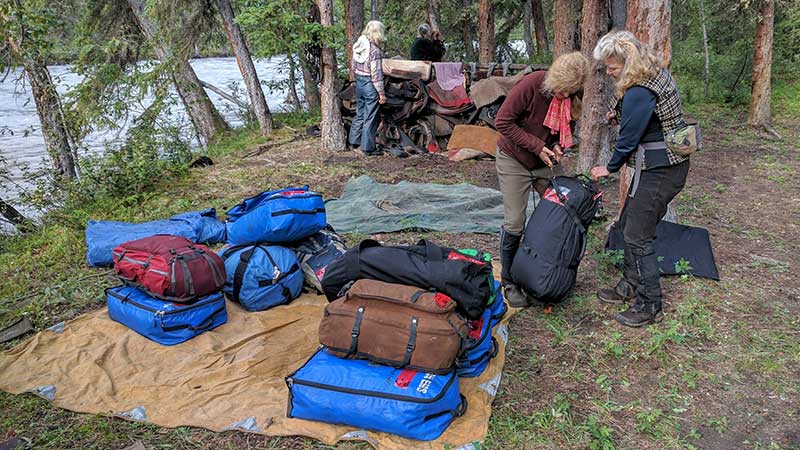
Each day’s routine was the same – but never boring, not a chance.
No, once back in the saddle, the M-K treated us daily to one primal, stunning vista and one extreme ride after another.
Sawchuk’s website promises the “expedition will be rigorous, exciting and utterly unforgettable.”
He’s sparing with his words and dead-on accurate.
On our first day’s ride out of Prophet River Camp, we ascended to a breathtaking alpine meadow chock-full of vibrantly coloured sky-blue forget-me-nots, cobalt delphiniums, purple monkshood and magenta fireweed.
While the blossoms were magnets calling us to look at our feet, the ocean of ridges stretching to the horizon compelled us to raise our eyes skyward.
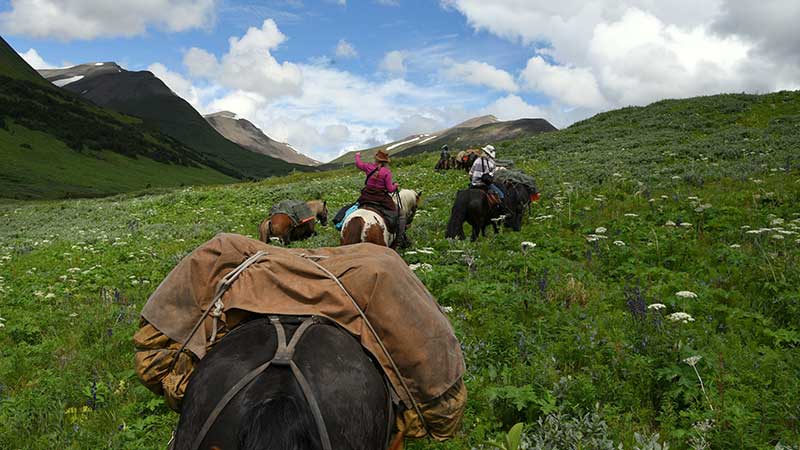
“Lunch!” Sawchuk would cry, being the call to stop, tie our horses to whatever we could, and open our saddlebags to extricate sometimes flattened but always tasty lunches we’d packed for ourselves.
Perhaps it’d be a wrap of peanut butter and celery; possibly a hunk of cheese, dried figs and crackers.
Whatever it was we washed down with fresh M-K spring water: delicious.
Consistently, M-K’s backcountry delivers major wows – whether that’d be vistas or major demands upon your body.
Horses are raised to this life; I’m not.
So these expeditions are “rugged” alright, if not extreme.
After all, when faced with an intense ascent or descent, another call comes down the line from Sawchuk. “We walk from here.”
And as you can well imagine, such cries are met with thankfulness or alarm, depending on how saddle sore you might be at any given moment.
Undeniably, steep sections tested everyone’s mettle, especially this summer of rain, when muddy trails kept you hopping, trying to keep from getting wet feet.
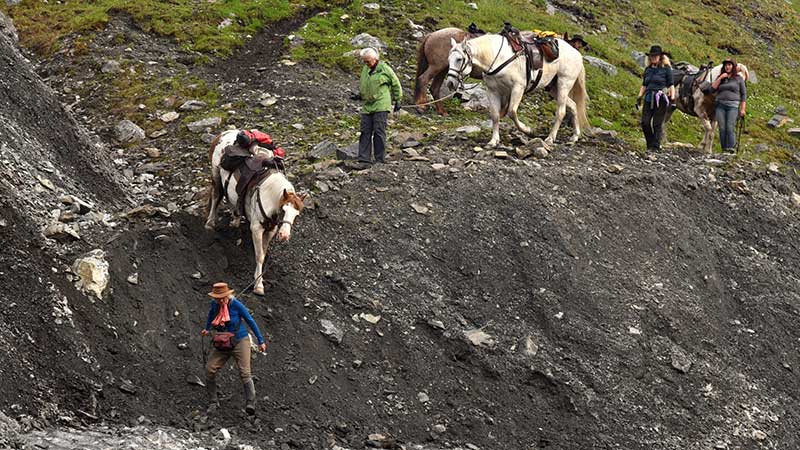
Who am I kidding? Remember those turbulent rivers I mentioned we crossed?
Well, I’ll tell you, keeping dry feet was impossible.
My wonderful horse had a Blackfoot First Nations name: T’suu (pronounced “Sue”).
This mare was short, and at least once Eric observed we were swimming while crossing a river. Sure I lifted my feet up – but frankly?
They got wet. Did I care? Nah. With woollen socks and good Ariat riding boots, I was right: perhaps a tad squishy but cosy, that’s for sure.
The paths are often simply wild animal trails, snaking along a mountainside, skirting a talus slope, or deeply cut by moose and other critters through waist-high willow.
In the M-K’s heartland here, you feel you are alone and at one with the wilderness because you are.
Days off, you ask?
Sawchuk recognizes a break is a rest, where he tries to achieve two days riding with the third day off.
That worked well for us, where the three other women and Eric and I became fast friends, respectful of one another’s space and capabilities.
One day off at Gatho River camp we hiked up Love Crash Creek to a waterfall.
We four women were assessing our route when all of a sudden we gasped: walking nonchalantly towards us, an immense bull moose stopped, gave us a double-take look, and blasted away through the willows.
Phew! Later on, we saw perhaps 40 elk plus another grizzly with twins – on the opposite side of the valley.
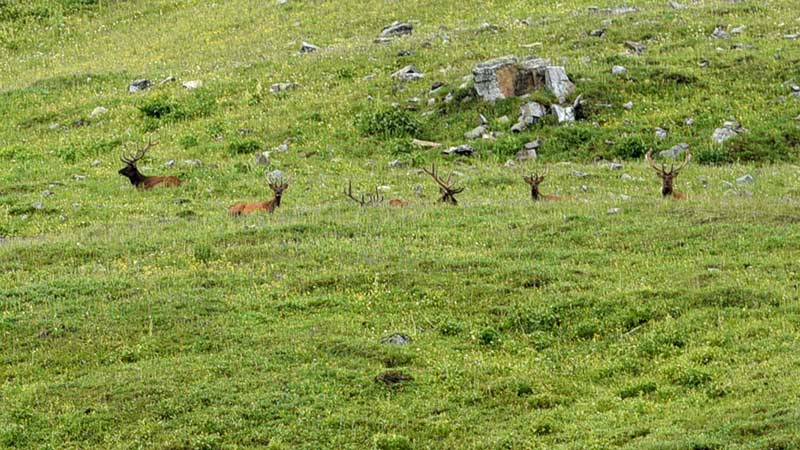
Love Crash Creek is quite a name and Sawchuk and Creegan-Dougherty spun the tale.
There was a lady working at a camp here, and a pilot took a fancy to her.
He decided to fly over her camp, drop a love letter and fly off… but he crashed.
The plane’s still there; the love crashed with him.
There’s many a tale to spin here. Like Charles Bedaux’s 1934 expedition.
This French-American millionaire passed through the M-K testing Citroën half-track vehicles that his friend André Citroën was making.
Bedaux hired 100 pack and riding horses and more than 50 cowboys at double the going rate of the day.
His so-called “Champagne Safari” included his wife, mistress and cook – who all wore exactly the same clothes, so the story goes.
Interesting times, methinks… His aim? To travel the 2,414 km or so from Edmonton, Alberta to Telegraph Creek, BC.
Although they never made it, the story lingers, the mind boggles… and although his original footage was lost, in 1995 The Champagne Safari movie was released.
Ahhh. So many tales. So many wonders to discover.
When you go, because go you surely must ask Lepp to recite the Bard of the North (Robert Service’s) poem, The Cremation of Sam McGee.
At the end of our trip, on the sandy beach overlooking turquoise Tuchodi Lake, Lepp stood, squared his shoulders, and told the tale.
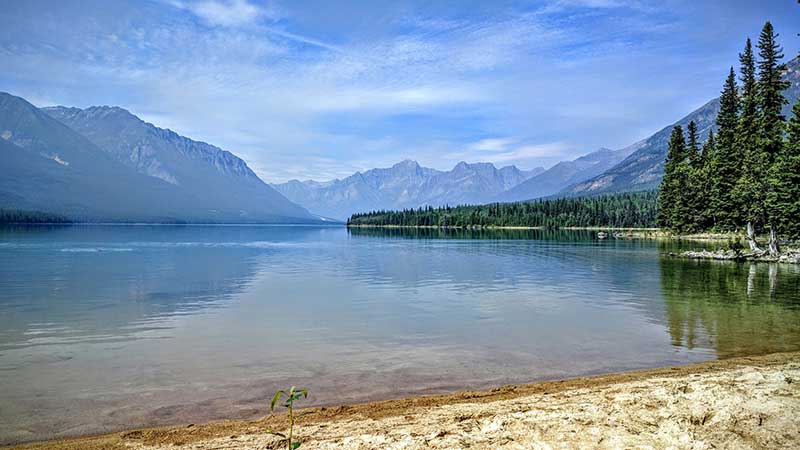
As his voice rang out over the lake embraced by yet another ridge ocean, I cried.
Once again I have lost my heart to the wild.
The Muskwa-Kechika, both the land and its protectors – Wayne, Alex and Michelle – have captured my soul yet again.
As we sped along the Tuchodi, then Muskwa Rivers in the jet boat during the 4.5-hour trip out, I chatted with the pilot.
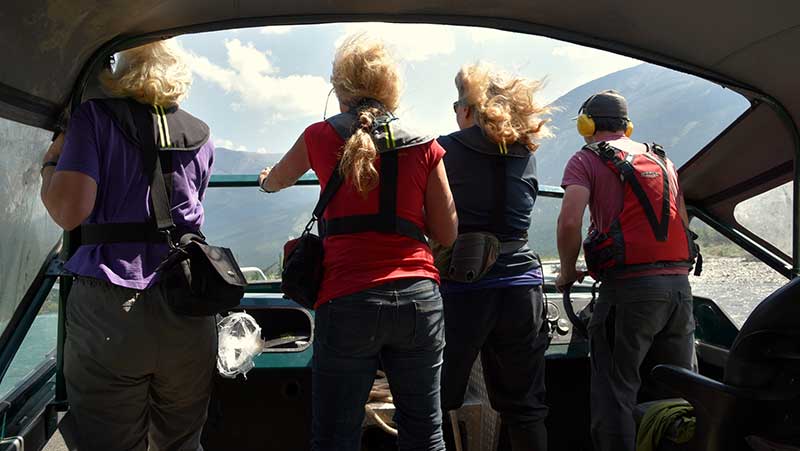
He’s been smitten too, bitten by the call to preserve, protect and love this land and its wild heart.
You can too: whether you’ve ever sat a horse or not, Sawchuk and his wranglers will treat you to a place you never thought you’d see, never thought you could hike and ride through.
Go, and lose your heart to the M-K.
Katharine and Eric Fletcher are keen outdoors enthusiasts who lost their hearts to British Columbia’s wilderness.
Find out more here .
For more attractions in Vancouver and on Vancouver Island read:
- 50 Incredible Things To Do In Vancouver
- 10 Best Hotels in Vancouver
- Hiking The Lions
- Stanley Park’s Totem Poles
- Capilano River Park Walk
- Haida Gwaii
- Nimmo Bay Lodge
- Vancouver at night
- Vancouver Island Camping
- 10 Incredible Vancouver Island Resorts
- 11 Things To Do On Vancouver Island
- 10 Things To Do In Victoria
- Butchart Gardens For All Seasons
- Orca Whale Watching From Victoria
- Telegraph Cove
- Where To Stay In Vancouver
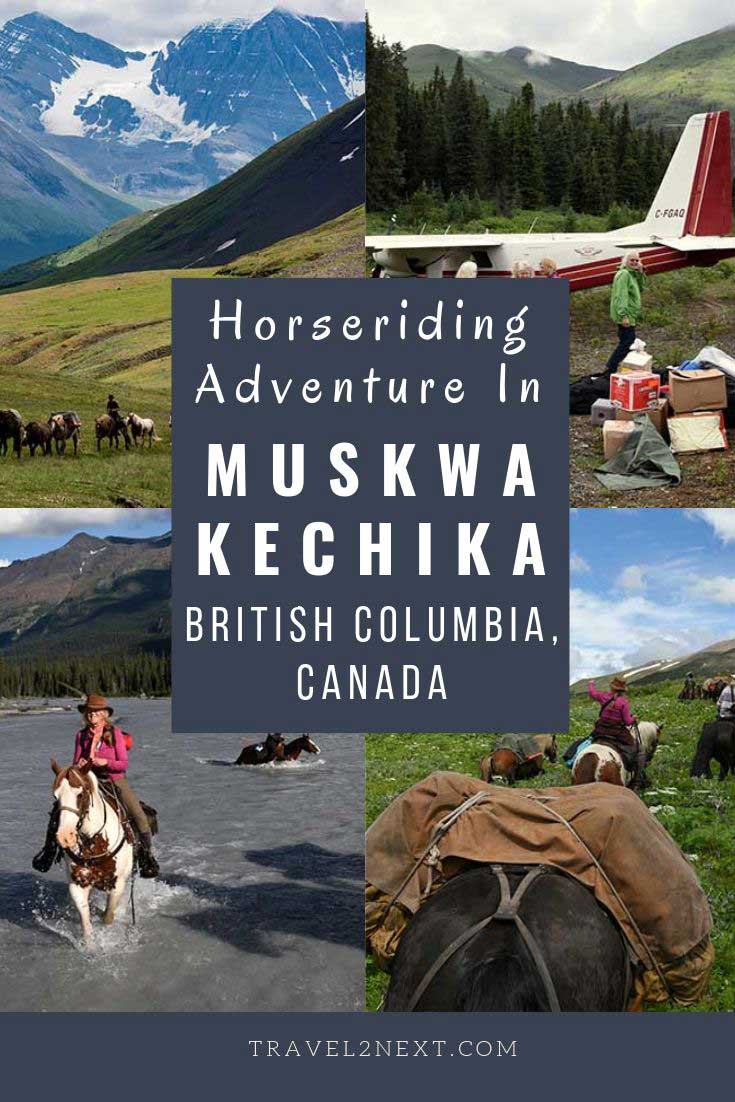
Plan Your Trip

Rent A Car – Find the best car rental rates at Discover Cars . They compare car hire companies to provide you with the best deal right now.

Find A Hotel – If you’re curious about this article and are looking for somewhere to stay, take a look at these amazing hotels .
Things to do in Canada
26 famous landmarks in canada, what is canada known for, banff in winter, 20 things to do in ontario, christmas in toronto, editor's picks, 101 travel quotes – inspiring the journey, 60 luxury escapes for your bucket list, 25 australian landmarks.

Wake up among giants: go wild camping in British Columbia’s mountains
If you really want to unplug, off-grid camping in British Columbia’s wildest mountain landscapes offers the chance to be at one with nature and enjoy magical encounters with Canada’s most iconic wildlife.
This is a place on a truly epic scale. Camp or glamp in these remote wilds on Canada's west coast and you’ll find space to breathe, think and press the reset button. In the wake of the pandemic, British Columbia feels like freedom itself: whether you’re paddling into a pink dawn, watching a bear pouncing on a sockeye salmon or clambering up to a ridgetop log hut as the dying sun sets the sky ablaze. And what better way to complete the experience than through wild camping? The night sky and all that lives beneath it will reveal itself, stirring the senses with the sounds of wildlife, the rain falling through the tree canopy and a gentle breeze rustling through giant cedar trees. It’s time to tune into the present and embrace the healing powers of British Columbia's great outdoors.

WAKE UP IN THE WILDERNESS
1. Hike hut-to-hut on the Sunshine Coast Trail As the golden morning light trickles through the old-growth fir and cedar canopy, sling on your backpack and embrace the new day on the trail. Rambling from sea level to summit, rainforest to river, along creek and fjord, this challenging 112-mile hike from Sarah Point in Desolation Sound to Saltery Bay is the backcountry dream. You can camp at designated spots (and be sure to hang your food in a bag) or stay in a shelter on Canada’s longest hut-to-hut hiking trail. Wildlife? You bet. Bears, wolves, coyotes, elk, racoons, eagles, otters, seals and whales are regularly sighted. 2. Camping at Tatlayoko Lake, Chilcotin Country A raw wilderness of rock and ice unfolds above wind-whipped Tatlayoko Lake in Chilcotin Country, where your gaze will be drawn magnetically to 10,443ft Razorback Mountain, the highest peak of the Niut Range. Climbing it is for experts only, but at lake level, you can back-to-nature camp on the lake's northern shores and canoe, kayak, fish, windsurf, hike or bike in view of those exquisite blue waters. Bring binoculars for sightings of the deer, moose, bighorn sheep and grizzlies that thrive in the lake’s remote surrounds.

3. Grizzly-spotting along the Chilko River Few experiences thrill like watching a grizzly bear swipe the water with claws outstretched, then feast on salmon. Chilko Lake in Ts'ilʔos Provincial Park is a place that provides just that — on a nature walk, river excursion or sunset boat trip. A stay in a riverside safari tent brings you right in the heart of this incredible wildlife-rich environment, with black bears and grizzlies, moose, cougar, wolverine and bald eagles to spot safely with a guide. And the backdrop is just as riveting, with dark, glaciated 9,000ft peaks rising above a fjord-like expanse of startlingly turquoise water. 4. Go remote in Muskwa-Kechika Hear that? Total silence. If you want to give everyday life the slip, there’s no place like the wild, wild Muskwa-Kechika in the Northern Rockies. A floatplane over the Alaska Highway and Toad River drops you amid the peaks at remote, rugged Mayfield Lake, where handcrafted tipis are the base for treks on foot and horseback with conservationist, author and photographer Wayne Sawchuk. You can go for weeks and barely see a soul, bar the odd bear, moose or caribou. Back at camp, yoga, meditation, canoeing and campfires help you click into nature’s mellow groove.

5. Canoeing the Bowron Lake Circuit Spring in Bowron Lake Provincial Park is special: the waters gently start to warm as the forests wake up from hibernation, and the mountains' snowy peaks slowly start to melt away. As you paddle across the glassy water in quiet exhilaration, something moves on the shore. A black bear? A moose? A caribou? Anything is possible. You’ll see more wildlife than people on the 72-mile Bowron Lake Canoe Circuit , which takes you off the beaten track, even by Canada’s backcountry standards. Experiencing the full circuit can take some six to 10 days to hike, meanwhile the shorter half-circuit, the West Side Trip, takes between two and four. This is a self-sufficient adventure, with days spent at water level and starry nights at wild camps or by cooking shelters, but can be completed as part of a guided tour , too. 6. Hut-to-hut hiking in the Valkyrs The rarely-explored Valkyr Range in the Columbia Mountains is a nature-gone-wild alpine spectacle. The terrain is vast, and the backcountry trails and summit-bagging opportunities are boundless. With lodges perched high in the mountains, family-run Valkyr Adventures takes wilderness hiking to a new level, with a seven-day hut-to-hut traverse. How remote? Well, the only way to get there is by helicopter. Wildflower meadows, lakes, rivers and old-growth giant cedar forests are all part and parcel of this hike. While there is a self-guided option, a guided and catered hut-to-hut package gives you the option to have freshly prepared meals at the lodges, before soothing muscles in a sauna or hot shower and cosying under a down duvet in a double bed.

WILDERNESS GLAMPING IN BRITISH COLUMBIA
If you’re craving the wilderness but still like to have a few home comforts, British Columbia hits the nature-loving sweet spot with these top glamping picks.
1. Radius Retreat and Radium Hot Springs Bighorn sheep often block the roads through the springs to this nature-loving, eco-aware retreat , perched high on forested slopes. The Rocky Mountains hog the horizon and wilderness trails weave discreetly between custom-built yurts, which are named after the wildlife on view (osprey and elk, fox and raven). Yoga and forest-bathing or high alpine hikes in Kootenay National Park: you choose the level of action. Or, bathe in thermal waters at the historic Radium Hot Springs , with minerals in the water helping you to relax and rejuvenate. The comforting warmth of the firepit and wood-burning stove will be waiting for you on your return. 2. Boulder Mountain Resort near Revelstoke Though nature works on a colossal scale here, with bald eagles soaring high above, across a panorama of Glacier National Park's perennially snow-capped peaks, you might find yourself just as pleasantly moved by the smallest of nature's creatures. Walk among the towering hemlocks, giant cedars and spruces in the world's only inland temperate rainforest, watch for the electric-blue flash of the lazuli bunting songbird or the soothing trill of a chickadee. Boulder Mountain Resort's glamping tents deliver deep wilderness with a pinch of comfort; a hot tub and firepit await after a long day taking in the oxygen of the surrounding Columbia River basin. 3. Camp Moose Trail, near Golden There might be grizzlies, caribou and wolverine in these woods, but you’ll sleep safe and sound in your rustic-chic tent , complete with a queen-sized, log-built bed. At the foot of the granite spires of the Purcell Mountains, hiking trails sit pretty between the snow-encrusted peaks and ice-blue lakes of Glacier, Yoho and Banff national parks. Days spent hiking, trail-running, biking or paddleboarding ease into star-filled nights relaxing in the hot tub or by a crackling campfire.

Essentials
Getting there & around Vancouver International Airport is the obvious arrival point from the UK, and Air Canada and British Airways fly direct to Vancouver from Heathrow. Prices start from around £467 return. Since British Columbia was made for road trips, it's best to reserve car hires and any required BC Ferries sailings ahead of time, especially in summer.
How to do it Check whether excursions require day-use and/or overnight permits from Parks Canada or BC Parks , depending on the location you are planning to visit (when booking guided hikes, these are usually booked for the group in advance). When visiting any of the parks, take rubbish with you and leave no trace.
When to go British Columbia is beautiful year-round. While it rains a lot in the valleys in winter, if you head up into the mountains, this means there will be snow on the peaks. To really make the most of the province's incredible natural bounty however, come in the late spring (sub-alpine) and summer (alpine) when the temperatures rise and more of BC's wilderness is accessible to visitors.
Nature has a lasting effect on us and experts say that the bigger the nature, the better. Take a moment and connect with British Columbia's great wilderness, even before you travel. Call the Wild at HelloBC.com
Follow us on social media
Twitter | Facebook | Instagram
Related Topics
- ENVIRONMENT AND CONSERVATION
- WILDLIFE WATCHING
You May Also Like

The essential guide to visiting Alaska

How to visit Lake Clark National Park and Preserve
For hungry minds.

5 game drive alternatives, from cycling to horse-riding

Visiting Alaska? Here’s what the locals love.

Bears, wolves and rewilding in Romania's Southern Carpathian mountains

A guide to organising your second safari in Tanzania

How locals are protecting the wildlife of the Queen Elizabeth Conservation Area
- Terms of Use
- Privacy Policy
- Your US State Privacy Rights
- Children's Online Privacy Policy
- Interest-Based Ads
- About Nielsen Measurement
- Do Not Sell or Share My Personal Information
- Nat Geo Home
- Attend a Live Event
- Book a Trip
- Inspire Your Kids
- Shop Nat Geo
- Visit the D.C. Museum
- Learn About Our Impact
- Support Our Mission
- Advertise With Us
- Customer Service
- Renew Subscription
- Manage Your Subscription
- Work at Nat Geo
- Sign Up for Our Newsletters
- Contribute to Protect the Planet
Copyright © 1996-2015 National Geographic Society Copyright © 2015-2024 National Geographic Partners, LLC. All rights reserved
Prophet Muskwa Outfitters (Devilhole Outfitters, Ltd) Photos
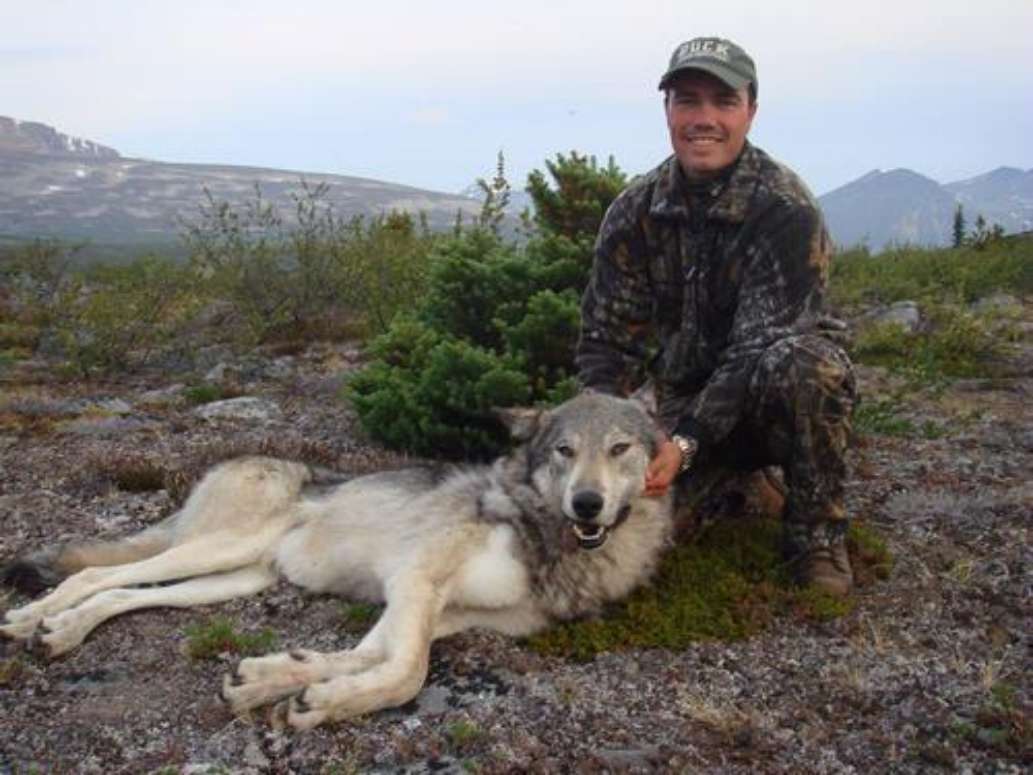
Prophet Muskwa offers clients more choice in locations and species with the high standards and focus on conservation that have been upheld over the years and will continue to be upheld in the forthcoming years. With locations in the Yukon and British Columbia, Prophet Muskwa offers clients excellent hunting opportunities for Rocky Mountain Elk, Canadian Moose, Alaska-Yukon Moose, Rocky Mountain Goat, Mountain Caribou, Continental Black Bear, Grizzly Bear, Mule Deer, Wolf,...
Prophet Muskwa Outfitters (Devilhole Outfitters, Ltd)
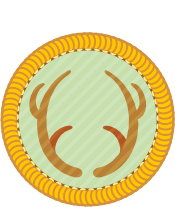
Prophet Muskwa offers clients more choice in locations and species with the high standards and focus on conservation that have been upheld over the years and will continue to be upheld in the forthcoming years. With locations in the Yukon and British Columbia, Prophet Muskwa offers clients excellent hunting opportunities for Rocky Mountain Elk, Canadian Moose, Alaska-Yukon Moose, Rocky Mountain Goat, Mountain Caribou, Continental Black Bear, Grizzly Bear, Mule Deer, Wolf,... Read More
- Fort St John, BC, Canada
- 250-789-9494
You own this business page.
Nobody owns this page.
About Prophet Muskwa Outfitters (Devilhole Outfitters, Ltd)
Write a great review
The more credible and helpful your review, the more likely it will be featured and seen on Global Outdoors. Learn what makes a great review.
- Include a title
- = 24" class="fa fa-check-circle" style="color:green;"> Write a review of at least 25 words
- 0" class="fa fa-check-circle" style="color:green;"> Include a photo
Your Review for Prophet Muskwa Outfitters (Devilhole Outfitters, Ltd):
Thanks for your review.
Your reviews are what make Global Outdoors great. Don't forget to share it online .
Reviews for Prophet Muskwa Outfitters (Devilhole Outfitters, Ltd):
{{review.title}}.
{{review.description}}
Prophet Muskwa Outfitters (Devilhole Outfitters, Ltd) replied {{moment(reply.createdTimeUtc).fromNow()}}:
{{reply.description}}
Thanks for your reply!
We're currently processing your reply and will email you once it has been published.
Prophet Muskwa Outfitters (Devilhole Outfitters, Ltd) replied :
Similar businesses, {{experience.title}}, send a message to prophet muskwa outfitters (devilhole outfitters, ltd).
Prophet Muskwa Outfitters
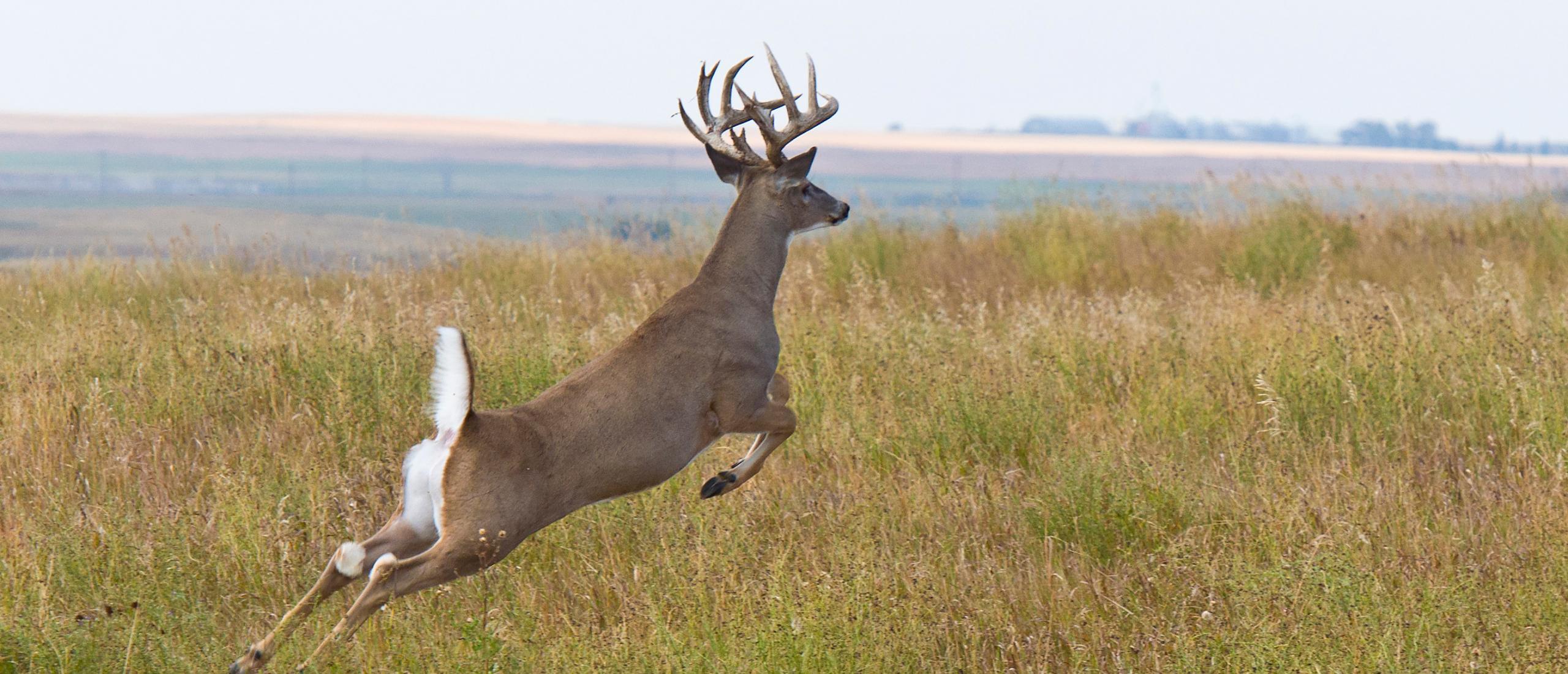
Sign up for exclusive offers with our newsletter
Receive special offers from our featured outfitters, featured articles, tips & tools.

Canoeing River Mukungwa
A half-day Canoeing River Mukungwa is an exciting safari adventure in Rwanda ’s lush countryside, on a gentle river that lies near Musanze! The Fee for Canoeing River Mukungwa is US$ 60. – per person. Discover a special way to travel, soak up impressive views, watch abundant bird species and look out for the otters, meet friendly local communities and find just a little excitement in modern canoes.
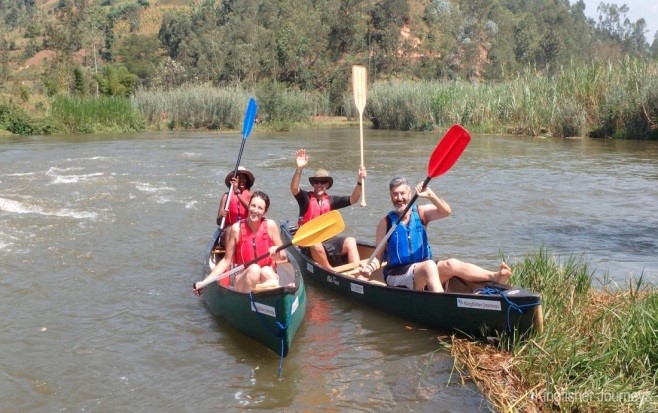
Some of the guests enjoying canoeing along River Mukungwa
Canoeing River Mukungwa is in two session, guests are free to opt for a morning or afternoon, both session gives a great time in the heart of the Rwandan countryside. Children from seven years are very welcome.
This is an incredible birding experience with nearly 40 species of birds spotted and regularly over 20 mostly aquatic species identified (by professional birders) on any single trip. Just a couple of hours from Kigali, this is the perfect activity for your trip to Rwanda the day before or after you visit the gorillas as it’s less than 30 minutes from all the main hotels near the Volcanoes National Park HQ where you go for gorilla trekking.
You will be supplied with modern, new buoyancy aids and have a qualified guide who will look after you on the water. A waterproof camera will be used to take photos that will then be shared with you shortly afterwards.
The whole trip from pick up to return lasts about 4 hours and don’t worry, there are no hippos or crocs in the water.
Approximate daily timings
Morning Canoeing River Mukungwa session
Start River Trip 08:30 Finish River Trip 12:30
Afternoon Canoeing River Mukungwa session
Start River Trip 14:00 Finish River Trip 18:00
Key observations while Canoeing River Mukungwa
- No experience is needed, but you should be reasonably fit and mobile. So, for example, if you’ve trekked to see the gorillas or are happy to ride a bicycle around town, this trip should be suitable for you.
- Canoe trip needs to leave promptly, so please be ready on time. There are no refunds for missed departures.
- Bring a hat, sunscreen and wear light clothes – such as shorts and a t–shirt that can get wet. A raincoat is also a good idea in the wet season.
- Most people go barefoot in the canoes, but footwear is necessary for when you get out at the end. Sandals work well and flip flops are ok.
- Please leave behind your jewelry, phones, cameras and anything else that could be damaged by water or lost if it doesn’t float!
- In the wet season, whilst mornings are usually dry, it’s common for there to be rain in the afternoons. Thunderstorms tend to pass quickly, so we don’t cancel trips because it’s raining – even if it is heavy rain.
This is a leisurely and exciting activity that visitors can engage in before or after Gorilla trekking in Volcanoes . It is also recommended to guests after a glimpse of the rare mountain gorillas, to proceed and visit the famous Chimpanzee Forest in Rwanda, Nyungwe Forest National Park to track Chimpanzee in Rwanda and also have the opportunity to do the Canopy walk tour in Rwanda
WhatsApp us
THE 10 BEST Moscow Parks & Nature Attractions
Nature & parks in moscow.
- Playgrounds
- Bodies of Water
- 5.0 of 5 bubbles
- 4.0 of 5 bubbles & up
- 3.0 of 5 bubbles & up
- 3rd Transport Ring (TTK)
- District Central (TsAO)
- District North-Eastern (SVAO)
- Garden Ring
- Good for Kids
- Budget-friendly
- Good for Couples
- Good for Big Groups
- Good for a Rainy Day
- Honeymoon spot
- Hidden Gems
- Adventurous
- Good for Adrenaline Seekers
- Things to do ranked using Tripadvisor data including reviews, ratings, photos, and popularity.

1. Sparrow Hills (Vorobyovy Gory)
2. Kuskovo Estate

3. Sokolniki Park

4. Gorky Central Park of Culture and Leisure


5. Victory Park

6. Aleksandrovskiy Sad
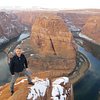
7. Aptekarskiy Ogorod Botanical Garden

8. Patriarch's Pond
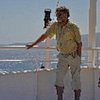
9. Neskuchny sad
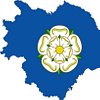
10. Moskvarium

11. Izmailovsky Park
12. Hermitage Garden

13. Moscow Zoo

14. Oceanarium RIO

15. Crocus Oceanarium
16. Lilac Garden

17. Park Zaryadye

18. Zaycafe

19. Central Botanical Garden

20. Serebryanyi Bor Park

21. Filevskiy Park

22. Meshherskiy Park
23. Sad Baumana
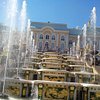
24. Boulevard Ring

25. Yekaterininskiy Park
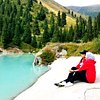
26. Ostankino Park

27. MGU Botanic Garden
28. The Tallest Cylindrical Aquarium in the World

29. Park Pokrovskoye-Streshnevo

30. Losiny Ostrov National Park
What travelers are saying

- Victory Park
- Gorky Central Park of Culture and Leisure
- Kuskovo Estate
- Sokolniki Park
- Aleksandrovskiy Sad
- Neskuchny sad
- Patriarch's Pond
- Aptekarskiy Ogorod Botanical Garden
- Lilac Garden
- Meshherskiy Park
- Park Novodevichi Prudy
- Crocus Oceanarium
- Oceanarium RIO
Get the most of your stay in Moscow
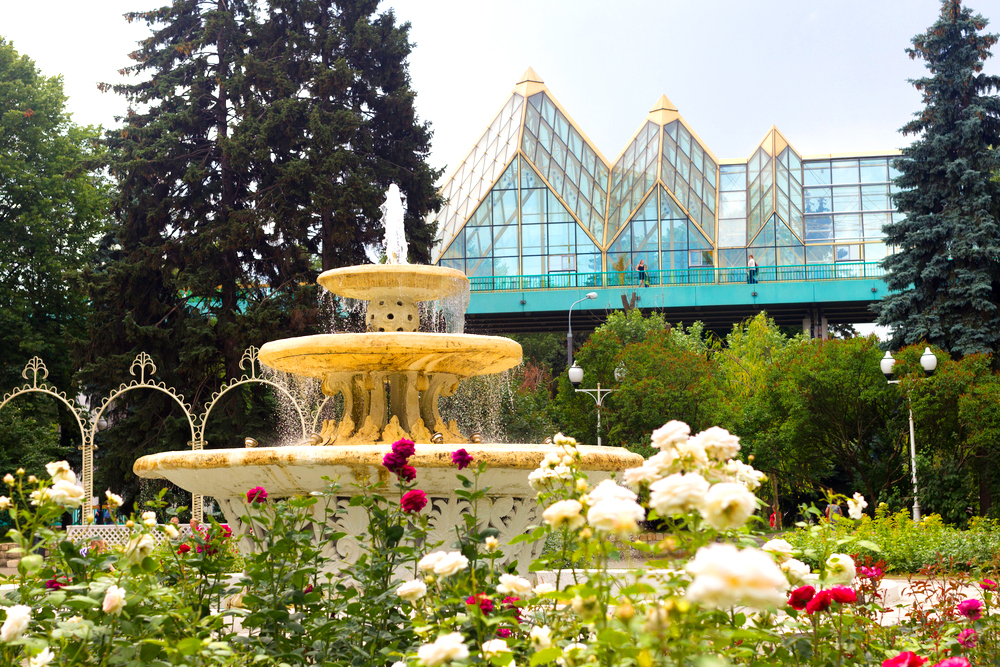
TOP-11 Moscow Parks to Visit
I have chosen the best 11 Moscow parks to visit and spend a beautiful time for you. Do not miss and choose one that you like the most – cycling, festivals, flowers, panoramic views and many other things are waiting for you!
Gorky Park (The Central Park of Culture and Leisure) – The main one of the Moscow Parks
In my opinion this park could be called the main park of the city. Why? Because of its huge territory, the central location and the amount of people visiting the park daily. It was founded in 1928 and in 2011 it was totally reconstructed. Now it pleases visitors with modern objects and soft green lawns.
- Oktybrskaya or Park Kultuty metro station, Krimsky Val, 9
The Gorky park is a the right choice for everyone! The youth will like a free WiFi, bicycles, skateboards and other rentals; the couples will enjoy spending time near the river, watching a sunset; parents will appreciate colorful playgrounds and a room for mother and child. Everyone can find something for themselves: from yoga classes to watching movies in a cozy summer cinema, from dance classes to volleyball playground. Gorky Park is also the venue for all kinds of exhibitions, festivals, events for children and adults. During the winter there is one of the biggest skating rinks in the park.
Museon Art Park – A Second Gorky they say
“Museon” is located on the opposite side of Krimsky Val street. And right now some people believe that Gorky and Museon together is a one space sharing the same beauty.
- Oktybrskaya or Park Kultuty metro station, Krimsky Val, 2
The Park of Arts was named this way because there is the largest composition of open-air sculptures in Russia. In its territory there are already more than 1000 unique exhibits: from monuments of the socialist realism era to various kinds of contemporary art. But this is not all the attractions of the park. In recent years, “Museon” has become an important cultural site of the city. The park regularly hold many different concerts, festivals, educational projects in the field of art and design. There is a Central House of the Artist, a comfortable summer cinema and other attractions on territory. Be sure to stroll pedestrian Crimean embankment, which looks like a modern park.
Neskuchny Garden – True Russian Nature is Here
Neskuchny garden is located on the right bank of the Moscow River. Today it is also seen as a part of the Gorky Park. This landscape park is one of the oldest in the city and is protected by the state. Its name was received from the Neskuchnoye Estate of Prince Trubetskoi which is still located in the park.
- Leninsky Prospekt metro station, Leninsky Prospect, 30
This park is famous mostly for its location close to the Gorky park. It is a quite place with true nature, lots of trees and squirrels and also ancient architecture. As in every park, there are sports and playgrounds, cafes and even a football field.
Zaryadye Park – 5 Steps Away From The Red Square
The area of this brand new park was opened only in September 2017 and located in the very heart of Moscow – right near the Red Square.
- Open from 10AM to 10PM
- Teatralnaya, Okhotnyi ryad, Ploschad Revolutsii
The park has 4 zones, each of them represent different parts of Russian landscapes. Above the river there is a floating bridge from where you get to see one of the best panoramic views on Moscow. Other attractions of the park are 5D cinema where you can take a flight above Moscow, few cafes and restaurants, pretty lakes with fishes and old preserved churches. In addition there is still being built a philharmonic hall, covered with a huge dome and an Ice cage where the temperature will always stay below zero degrees.
When you are on the Red Square do not miss it!
All-Russia Exhibition Center (VDNKh) – The Soviet Style Moscow Park
Park VDNKh – one of the most famous parks in Moscow. This park is one of the sights of the city as it hasn’t changed much since the Soviet era.
- VDNKh metro station, Prospect Mira, 119
The symbol of VDNKh is a fountain with 16 women symbolizing the friendship of the nations of the USSR. Around this fountain there are all the pavilions representing 16 republics. Now inside the pavilions you find various shops, cafes and exhibitions. If you go deep inside the park you will find a rocket Vostok and and an aircraft. What is funny the inside of the aircraft there is actually a photo exhibition. Near the northern entrance you there is a famous sculpture “Worker and Kolkhoz Woman”. It is extremely famous among Russians as all the movies by Mosfilm corporation used to start with the picture of this statue. But if you go further inside the park you will reach a very calm area. A lake is there, forest and birds singing. Since the park occupies a large area I suggest you to rent a bicycle.
Sokolniki Park – A Place For A Hunt Or For Leisure?
The park got its name because of the royal falconry, which took place there in the past when there was a dense forest. (Sokol means a falcon.) In 2011 it was significantly transformed: updated lawns, landscaped ponds and picnic areas, restored summer cinema and theater, a large rose garden, sports grounds, bicycle paths and other things.
- Sokolniki metro station, Sokolnichesky Val, 1, p. 1
From the main entrance along the alley you can walk to the Sokolniki circle, where 8 alleys form 9 sectors, in each of them you will find trees of the same breed. The park is famous for its rosary, as well as flower decoration. On the territory of the park there are concert halls, a library, amusement zone, dances zone and many many other attractions. In winter the park has a skating rink (a free of charge one) and ski runs. During the warm season you can rent a bicycle.
Tsaritsino Park – A Different World Inside Moscow
Here you can walk for hours, admiring the most beautiful nature and magnificent architecture.
- Open from 6AM to 12AM
- Tsaritsyno metro station, Dolsky, 1
The most amazing part of the park is the lake with a light and musical fountain. Every evening the fountain starts the show. Lights and music combined make you feel like you are not in Moscow but in a fairy tale. The park is also well equipped for sports lovers and healthy lifestyle. There are volleyball and basketball courts, a tennis court, sports facilities for acrobatics, bodybuilding equipment.
What I personally like about this park is the atmosphere. This place is actually far from the city center but I love going there anyway. Whenever I go there I feel like I left Moscow with all its hectic lifestyle. It is the place where I relax, enjoy myself or a company of my friends and feel kind of different. By the way totally suggested for a date!
Kolomenskoye Park – Combination Of Reserve and Architecture
The Kolomenskoye park is actually a Museum-Reserve. It is a former residence of Russian tsars and one of the most scenic places in Moscow.
- May to September – open from 8AM to 12AM, October to April – from 8AM to 9PM
- Kolomenskoye metro station, Andropov Ave, 39
Alike with Tsaritsino park Kolomenskoye park has its own special atmosphere with all the architecture, trees, ponds and even a river bank. The park regularly hosts various folk festivals and different fairs. In summer time you can play with kites or rent a bicycle and ride around the huge area of the park.
I love the view that you get on the city from one of the hills near the river. I love the apple trees alleys and the beautiful churches. It is also a bit far from the city center but yet worth going there. One of my best friends even celebrated her wedding there.
Aptekarsky Garden or Botanical garden of the Moscow State University – The Best Botanical Garden in The World
Aptekar in Russian language means a pharmacist so basically it is a pharmacist’s garden. It was founded in 1706 by Peter The Great for growing medicinal plants for the royal family. But later they moved it from under the walls of the Kremlin to the current location.
- Open from 10AM to 8PM
- Prospect Mira metro station, Prospekt Mira, 26
In the botanical garden there are no attractions and noisy crowds of tourists. The area of the garden is not as big as any other park in Moscow. And the entrance is not free. But this exactly what makes this park one of the most comfortable in the city. In the Aptekarsky garden they grow thousands of different plants, flowers and trees. Some of the trees are more than 300 years old. They held different festivals there: flowers festivals, sand and ice sculptures expositions.
For me it is one of the most beautiful parks not only in Moscow but in the world. I have never seen so many different flowers and plants anywhere else. And trust me I am a real park lover. And what is more the staff really takes care about every single tree or plant there, some of the trees have names and stories. I love it there and I think the price is really worth what you get.
Victory Park – A Park That Makes Us Remember The War
The park is located on the Poklonnaya Hill and it has one of the world’s largest memorial complexes dedicated to the World War II. The park was opened for the 50th anniversary of the Victory on May 9, 1995. It is also one of the main venues in the city for holding a variety of mass events.
- Park Pobedy metro station, Brothers Fonchenko, 7
On the main avenue of the park there are with 1418 fountains – exactly as long as the war lasted. Fountains make five water terraces, symbolizing five years of military operations. And in the center of the park there is the Museum of the Great Patriotic War. If you are interested in the history of the war do not miss it. The Poklonnaya Hill is a part of the park and from the hill you get one of the best views on the city of Moscow. And I could say this is the best place for watching the fireworks during the mass celebrations. But be aware it gets too crowded then. As in most of the other big parks you can rent a bicycle or rollers there.
Izmailovsky Park – A Mix of a Big Forest and Attractions
Izmaylovsky Park occupies a huge green territory, making up a large part of the Izmailovo district. The park consists of two parts: Izmaylovsky Park of Culture and Rest and the forest park of Izmailovo. First part is full of attractions and restaurants while the second one is like a real forest with pine trees, birch groves, beautiful clearings and ponds.
- Izmaylovskaya, Shosse Entuziastov or Partizanskaya metro stations, Izmaylovsky Park
It is easy to spend there a whole day. A large landscaped area and a lot of various entertainments for children and adults will help you not to get bored. An observation wheel, a boat station, children’s playgrounds, a dance floor, sports grounds, a skate park – all this is only a small part of the possible leisure activities. In the park there are bike paths and a rental services.
I don’t go there often to be honest. But the park is very very close whenever to a souvenir market on Partizanskaya metro station. And whenever the weather is nice and I have enough of free time I stroll through the alleys of the park and enjoy the nature. So if you are going to the souvenir market too and you have enough free time then do go to the park too.
5 thoughts on “TOP-11 Moscow Parks to Visit”
Pingback: Places to visit in Moscow – Sheran Bhattacharyya
Yes, sure 🙂 This is my top list 🙂
Yes, sure. These are my favorites!
I like this blog very much. Please keep sharing it in future too.
Thanks for sharing.
Thank you! 🙂
Leave a Comment Cancel Reply
Your email address will not be published. Required fields are marked *
- Skip to primary navigation
- Skip to main content
- Skip to primary sidebar
- Skip to footer
TravelAwaits
Our mission is to serve the 50+ traveler who's ready to cross a few items off their bucket list.
19 Unique And Fabulous Experiences In Moscow

- Destinations
Thinking of visiting Russia? When visiting such a famous city, one must, of course, visit the iconic landmarks first. Moscow has plenty of those, most of them in the center of the city, which is very well-planned for tourists. Once you’ve seen the sights that are on most travelers’ lists, it’s time to branch out and visit some of the lesser-known sites, and there are some fascinating places to see and things to do.
I know this list is long, but I just couldn’t help myself. You probably won’t have the time to see them all. But that’s okay. Just scroll through the list and choose what sounds the most interesting to you. Where possible, make sure to book in advance, as things can get crowded, especially during high season.

1. The Red Square, Kremlin, And Surroundings
Red Square (Krasnya Ploshad) is the heart and soul of Russia, and where much of the country’s history has unfolded. This is the most famous landmark in Moscow and indeed the whole country, it’s an absolute must-do! The square is always full of people and has a rather festive atmosphere!
Saint Basil’s Cathedral
This is the famous church with the rainbow-colored, onion-domed roof. The cathedral was commissioned in the 1500s by Ivan the Terrible and according to legend, the Tsar thought it was so beautiful, that he ordered that the architect’s eyes be cut out afterward, so he could never build anything more beautiful! He wasn’t called Ivan the Terrible for no reason!
Lenin’s Mausoleum
The “love-it-or-hate-it” of tourist attractions in Russia. A glass sarcophagus containing the embalmed body of Russian revolutionary, Vladimir Lenin. It may seem a bit bizarre to display the mummy of a person, but it has been there for almost half a century and the 2.5 million visitors who come each year, clearly feel the queuing and thorough body search are worth it, to be in Lenin’s presence.
Pro Tip: no photos and no loud talking are allowed inside the Mausoleum.
Eternal Flame
There is an Eternal Flame in honor of an unknown soldier on the left side of Red Square. The hourly changing of the guards is worth seeing.
The Kremlin is the official residence of the Russian president. You can see it from the outside, or you can take an excursion to one of the museums located inside. This is the biggest active fortress in Europe, and holds a week’s worth of attractions! Once behind the 7,332-feet of walls, there are five squares, four cathedrals, 20 towers, various museums, and the world’s largest bell and cannon to see. Worth a special mention is the Armory Chamber that houses a collection of the famous Faberge Eggs.
Pro Tip: You can only go inside the Kremlin if you are part of a tourist group.

2. Bolshoi Theatre
Bolshoi Theatre translates to “The Big Theatre” in Russian, and the building is home to both the Bolshoi Ballet and Bolshoi Opera — among the oldest and most famous ballet and opera companies in the world.
Pro Tip: It’s hard to get an inexpensive ticket, so if you’re reading well in advance of going to Moscow then try buying tickets on the official website . Last-minute tickets cost around $250 per person. If this is out of your budget, about an hour before a performance, you can try buying a ticket at the entrance from a reseller. Most can speak enough English to negotiate the price.
Tour the Bolshoi Theatre: You can take a group guided tour of the Bolshoi Theatre which focuses on the history and architecture of the theatre and behind the scenes. There’s an English language tour that lasts 2 hours and costs around $300 for a group of up to six.

3. Luxury Shopping At GUM And TSUM
Russia’s main department store, GUM, has a stunning interior that is home to over 100 high-end boutiques, selling a variety of brands: from luxurious Dior to the more affordable Zara. Even if shopping is not on your Moscow to-do list GUM is still worth a visit; the glass-roofed arcade faces Red Square and offers a variety of classy eateries. TSUM, one of the biggest luxury malls in town, is right behind the Bolshoi and GUM. It’s an imposing building with lots of history, and worth a visit just for its design and its glass roof.

4. Christ The Savior Cathedral
This is one of Russia’s most visited cathedrals and is a newer addition to the gorgeous array of Muscovite cathedrals, but don’t let its young age fool you. After perestroika, in the early 90s, the revived Russian Orthodox Church was given permission to build a cathedral on this site. It did the location honors and built the largest temple of the Christian Orthodox Church. The façade is as grand as you’d expect, but it’s the inside that will mesmerize you, with its domes, gold, gorgeous paintings, and decor!
The cathedral is located just a few hundred feet away from the Kremlin and was the site of the infamous Pussy Riot protest against Putin back in 2012.
Pro Tip: Bring a shawl to cover your hair as is the local custom.

5. Gorky Park
Moscow’s premier green space, Gorky Park (Park Gor’kogo) is the city’s biggest and most famous park. There is entertainment on offer here for every taste, from outdoor dancing sessions to yoga classes, volleyball, ping-pong, rollerblading, and bike and boat rental in summer. In winter, half the park turns into a huge ice skating rink. Gorky Park is also home to an open-air movie theater and the Garage Museum of Contemporary Art. There is also Muzeon Art Park, a dynamic contemporary space with a unique collection of 700 sculptures. It is located right in front of Gorky Park.
6. Sparrow Hills Park
If you take a walk from Gorky Park, along the Moscow River embankment, you’ll end up in the city’s other legendary park, Sparrow Hills. Although the park doesn’t offer as many activities as its hip neighbor, it has a great panoramic view of the city
Pro Tip: You can take a free walking tour to all of the above attractions with an English-speaking guide.

7. River Cruising
One of the best ways to experience Moscow, and see all the famous landmarks, but from a different angle, is from the Moscow River. Take a river cruise. Avoid the tourist crowds. There are little nameless old boats that do the cruise, but if you are looking for a more luxurious experience take the Radisson Blu cruise and enjoy the sights with some good food and a glass of wine.

8. Metro Hopping
Inaugurated in the 1930s, the Moscow Metro system is one of the oldest and most beautiful in the world. Started in Stalinist times, each station is a work of art in its own right. I’d recommend touring the stations between 11 a.m. and 4 p.m. This way, you’ll be able to properly see it without the crowds. Ideally, I’d recommend taking a tour with a knowledgeable guide with GuruWalk, who will tell you stories of forgotten stations and how the history of the country is interconnected with the metro development. If going by yourself, then I definitely recommend checking out: Mayakovskaya, Ploschad Revolutsii, Kievskaya, Kropotkinskaya, Kurskaya, and Novoslobodskaya stations.
Visit the free Moscow Metro Museum: For real train enthusiasts, located in the southern vestibule of Sportivnaya station is a small free museum. Here you can take a peek into the driver’s cabin, see a collection of metro tokens from different cities, and see different models of a turnstile, traffic lights, escalator, and more.

9. Moscow State University View
In his effort to create a grander Moscow, Stalin had seven skyscrapers built in different parts of town; they’re called the Seven Sisters. The largest of these buildings and the one with the best view is the main building of the Moscow State University. Although this is a little outside the city center, the view is more than worth it.

10. Izmailovsky Market
Mostly known for the city’s largest flea market, the district of Izmaylovo is home to a maze of shops where you can get just about anything, from artisan crafts to traditional fur hats, handcrafted jewelry, fascinating Soviet memorabilia, and antiquities. It’s also one of Moscow’s largest green spaces. There are often no price tags, so be prepared to haggle a bit. Head to one of the market cafes for a warming mulled wine before continuing your shopping spree.
The History of Vodka Museum is found here, and the museum’s restaurant is the perfect place to sample various brands of the national drink.
Once you’ve covered the more touristy spots, Moscow still has plenty to offer, and the places below will also be full of locals! So for some local vibes, I would strongly recommend the spots below!

11. Moscow City
With a completely different vibe, Moscow City (also referred to as Moscow International Business Center) is like a mini Dubai, with lots of impressive tall glass buildings. Here is where you’ll find the best rooftops in towns, like Ruski Restaurant, the highest restaurant both in Moscow City and in Europe. Moscow City is great for crowd-free shopping and the best panoramic views of the city.

12. Tretyakov Gallery
Tretyakov Gallery started as the private collection of the Tretyakov brothers, who were 19th-century philanthropists. They gave their private collection to the government after their deaths. If there is just one museum you visit in Moscow, I recommend this one!

13. Tsaritsyno Museum-Reserve
Tsaritsyno was a residence of Catherine the Great more than two centuries ago. It became derelict during the Soviet era but has now been fully renovated. With its opulently decorated buildings, gardens, meadows, and forests, Tsaritsyno Park is the perfect place for a green respite in Moscow.

14. Kolomenskoye
A 10-minute metro ride from the city center is Kolomenskoe Museum-Reserve, where you can get an idea of what Russia looked like 200 years ago. You’ll find ancient churches (one dating back to the 16th century), the oldest garden in Moscow, and the wonderful fairytale wooden palace of Tsar Alexey Mikhailovich, father of Peter the Great.

15. Ostankino TV Tower
Built in 1967, Ostankino TV Tower was the tallest free-standing construction in the world at the time, it’s still the 8th tallest building in the world and the highest in Europe. It’s also the best observation deck, with a glass floor and 360-degree views. The speedy elevators take you 1,105 feet in next to no time.
Pro Tip: You need to book in advance; entrance is based on specific ticket times and the capacity is limited and only a certain number of tourists are allowed per day. Don’t forget your passport, you’ll need it to get through security.

16. Zaryadye Park
Zaryadye is a newly opened, landscaped urban park so new you won’t find it in a lot of tour guides. The park is near Red Square and is divided into four climatic zones: forest, steppe, tundra, and floodplains, depicting the variety of climatic zones in Russia.
These last three suggestions are a little quirky, but all are really worth checking out.
17. Museum Of Soviet Arcade Games
Release your inner child playing on 66 arcade machines from the Soviet era! What a great way to spend a couple of hours when tired of visiting museums and palaces. The staff speaks excellent English and are happy to explain how the games work.

18. Moscow Rooftop Tour
Take a 1-hour private Moscow rooftop tour with an experienced roofer. I can just about guarantee none of your friends will be able to say they’ve done it! For your comfort, I recommend wearing comfortable shoes. Take your camera, there are some amazing photo opportunities out there!

19. Sanduny Banya
This classical Russian bathhouse opened its doors in 1808 and is famous for combining traditional Russian banya services with luxurious interiors and service. If you enjoy spas and saunas, then you should experience a Russian bathhouse at least once in your life! Go with an open mind and hire a specialist to steam you as it’s meant to be done — by being beaten repeatedly with a besom (a leafy branch)! This is said to improve circulation, but is best done by a professional!
So there you have my list of things to do in Moscow. I could have gone on and on and on, but I didn’t want to try your patience! There are so many things to do in this vibrant city that you’ll definitely need to allocate several days for exploring.
Here are some other reasons to visit Moscow and Russia:
- 7 Reasons To Put Moscow On Your Travel Bucket List
- Russia 30 Years (And 30 Pounds) Ago
- Massive Mysterious Craters Appearing Again In Siberia

Born and raised in Sydney, Australia, before moving to Africa at the age of 21, Sarah Kingdom is a mountain climber and guide, traveler, yoga teacher, trail runner, and mother of two. When she is not climbing or traveling she lives on a cattle ranch in central Zambia. She guides and runs trips regularly in India, Nepal, Tibet, Russia, and Ethiopia, taking climbers up Tanzania’s Mount Kilimanjaro numerous times a year.

IMAGES
COMMENTS
Outfitters. Prophet Muskwa offers clients the best stone sheep hunting in the world as well as excellent hunting opportunities for Rocky Mountain Elk, Canadian Moose, Rocky Mountain Goats, Continental Black Bears, Mule Deer, Wolf, Wolverine, cougar, and Lynx. Our high standards, comfortable accommodations, and experienced guides paired with our ...
The Muskwa-Kechika Management Area encompasses a vast wilderness in BC's northern Rocky Mountains. Rich with wildlife, it is a vestige of the continental wilderness that once existed. Our Services. From rigorous full-on expeditions to enjoying wilderness at a more relaxed pace, our 2024 adventures are sure to provide the experience of a ...
The Muskwa-Kechika Management Area (M-KMA), situated in northern British Columbia, Canada and was designated in legislation (M-KMA Act and Regulation) in 1998. It is a globally significant area of wilderness, wildlife, ecosystems and cultures, that must be maintained in perpetuity. World class integrated resource management decision-making must ...
The Muskwa-Kechika is an immense expanse of wilderness that spans over 6.4 million hectares (15 million acres). This stands as the largest protected area in Canada's Rocky Mountains and the most biodiverse, with one of the highest concentrations of differing plant and animal species in North America. For thousands of years, the First Nations ...
About MK Adventures The Muskwa-Kechika Management Area (M-KMA) is located in northeastern BC and encompasses 6.4 million hectares (16 million acres) of land with varying levels of conservation, preservation and land use practices. Named after two great rivers that flow through it: the Muskwa and the Kechika, it has more species in greater abundance than […]
Mayfield Horse Camp, Aug. 13-20, 2023. Mayfield Lake (in the Dune Ze Keyih Provincial Park) offers the perfect escape and the ideal place to experience the Muskwa-Kechika. Located in the heart of BC's Northern Rockies and nestled in the Gataga River Valley, Mayfield Lake is rich in wildlife and wild scenery. Moose and caribou can be viewed ...
Muskwa River Adventures. , Fort Nelson. 250-775-0760. Open. Show on MapGet Directions. Offers wildlife viewing, guided hunting trips, fishing, rustic camping adventures, sightseeing, and photo safaris. Doug and Sandy McKee have a passion for the outdoors, hunting, boating and the experiences our natural surroundings provide and they truly enjoy ...
The Muskwa-Kechika is a 16 million-acre wilderness in northeast British Columbia. It was stewarded by Indigenous peoples for thousands of years, and today it is one of the largest remaining tracts ...
Muskwa-Kechika Horseriding Adventure . Life's like that here in northern British Columbia's Muskwa-Kechika (M-K), the largest authentic wilderness region in North America's Rocky Mountains. ... His so-called "Champagne Safari" included his wife, mistress and cook - who all wore exactly the same clothes, so the story goes.
Muskwa-Kechika is one of the largest wilderness areas in North America, with forests, mountains, lakes, rivers, waterfalls, hot springs and wetlands. ... A stay in a riverside safari tent brings ...
The Muskwa-Kechika is one of the most intact wild areas remaining on the planet. Four times the size of Vancouver Island, it is an area with few roads (98 per cent roadless) and little resource development. The result is intact forests, clean water, and healthy wildlife populations. Caribou, for example, are thriving there, unlike in southern B ...
Prophet Muskwa Outfitters, Fort Saint John, British Columbia. 2,605 likes. 34 years in the outfitting business!
Rich in history, majestic in nature, the northern stretch of the Alaska Highway through the BC's Northern Rockies offers sprawling vistas of rugged peaks, glacier-fed rivers, and crystal clear lakes. Often described as the "Serengeti of the North," this remote wilderness makes a veritable theatre for nature and wildlife viewing and is not ...
Prophet Muskwa offers clients more choice in locations and species with the high standards and focus on conservation that have been upheld over the years and will continue to be upheld in the forthcoming years. With locations in the Yukon and British Columbia, Prophet Muskwa offers clients excellent hunting opportunities for Rocky Mountain Elk, Canadian Moose, Alaska-Yukon Moose, Rocky ...
Prophet Muskwa offers clients more choice in locations and species with the high standards and focus on conservation that have been upheld over the years and will continue to be upheld in the forthcoming years. With locations in the Yukon and British Columbia, Prophet Muskwa offers clients excellent hunting opportunities for Rocky Mountain Elk, Canadian Moose, Alaska-Yukon Moose, Rocky ...
A half-day Canoeing River Mukungwa is an exciting safari adventure in Rwanda 's lush countryside, on a gentle river that lies near Musanze! The Fee for Canoeing River Mukungwa is US$ 60. - per person. Discover a special way to travel, soak up impressive views, watch abundant bird species and look out for the otters, meet friendly local communities and find just a little excitement in ...
Safaris in Moscow. 1. Rybokhotsoyuz. 2. Easy Russia Tour Guide. An excellent and reliable service which made my trip mesmorizing with easy moscow. Especially Anna is a wonderful... 3. UTS GROUP.
Discover the natural beauty and diversity of Moscow with Tripadvisor's guide to the best parks and nature attractions in the city. Whether you want to relax in a garden, explore a forest, or admire a lake, you will find plenty of options to suit your preferences. Read reviews and photos from other travelers and plan your perfect outdoor adventure in Moscow.
The Kolomenskoye park is actually a Museum-Reserve. It is a former residence of Russian tsars and one of the most scenic places in Moscow. Free. May to September - open from 8AM to 12AM, October to April - from 8AM to 9PM. Kolomenskoye metro station, Andropov Ave, 39.
5. Gorky Park. Moscow's premier green space, Gorky Park (Park Gor'kogo) is the city's biggest and most famous park. There is entertainment on offer here for every taste, from outdoor dancing sessions to yoga classes, volleyball, ping-pong, rollerblading, and bike and boat rental in summer.